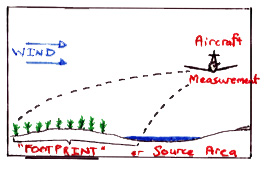 The Source Area responsible for a property manifested aloft
The Source Area responsible for a property manifested aloft  The Source Area responsible for a property manifested aloft
The Source Area responsible for a property manifested aloft "Measurements made at an elevated point may be accepted as representative of underlying patchy terrain only if the patchiness is predominantly on a scale small compared to the effective source area," (F. Pasquill).
The ground is normally patchy on scales from the minute to the continental: so we must place our instruments high to average the evaporation from a cornfield which is patchy with respect to soil moisture, plant spacing, etc. - but not so high as to be confounded by the contribution from a lake, or whatever, upstream.
We explain why the distribution of contact distance extends vastly further upwind than the footprint, and suggest for the extent (alongwind x, crosswind y) of the footprint the inequalities:
U h / sw < x < U T , abs(y) < sv x/U
where U is the windspeed, h is the observation height, sw and sv are the standard deviations of the vertical and lateral velocity fluctuations, and T is either (if h is above the surface layer) the Lagrangian timescale at height h, or, the ratio h/W of the observation height to W, the Lagrangian Similarity prediction for the rate of rise of the centre of gravity of a puff released at ground. h/Sw is the timescale on which gaseous elements climb from ground to h, and provides a lower limit on the time of flight of parcels contributing to the vertical flux seen at h. The upper limit (T) is the time aloft ensuring that, of all the elements released from distance x upstream and seen at h, as many will be moving up as down, resulting in no net contribution to the vertical flux.
Simple analytical solutions for the contact-time and the footprint are derived,. by treating the PBL as consisting of two sub-layers (the surface layer, and an overlying mixed-layer). The contact-time solutions agree very well with predictions of a Lagrangian stochastic model, which we adopt in the absense of meaurements as our best estimate of reality; but the footprint solution offers no improvement over the above inequality.